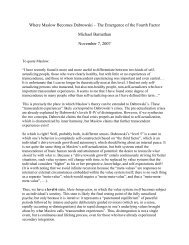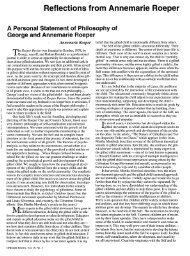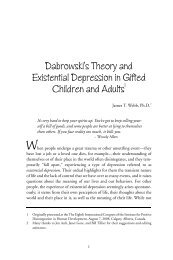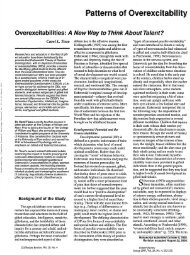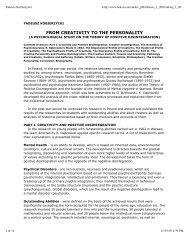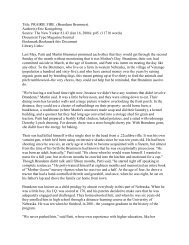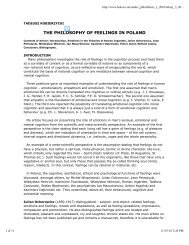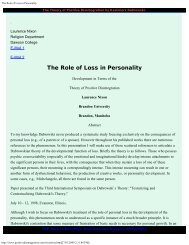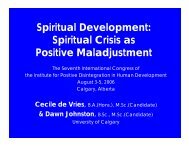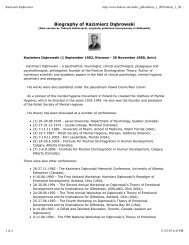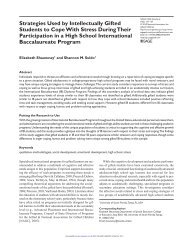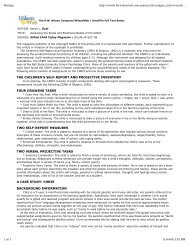POSITIVE MALADJUSTMENT - Kazimierz Dabrowski's Theory of ...
POSITIVE MALADJUSTMENT - Kazimierz Dabrowski's Theory of ...
POSITIVE MALADJUSTMENT - Kazimierz Dabrowski's Theory of ...
Create successful ePaper yourself
Turn your PDF publications into a flip-book with our unique Google optimized e-Paper software.
Welcome<br />
The Seventh International Congress <strong>of</strong> the<br />
Institute for<br />
Positive Disintegration in Human Development<br />
August 3-5, 2006<br />
Calgary, Alberta, Canada<br />
Positive Maladjustment:<br />
Theoretical,<br />
Educational and<br />
Therapeutic Perspectives.<br />
(All text in italics are quotations)
Positive Maladjustment<br />
“If you want to be a different fish,<br />
you have to jump out <strong>of</strong> the school”<br />
Captain Beefheart (Don Van Vliet).<br />
2
3<br />
Positive Maladjustment – Defined<br />
<strong>POSITIVE</strong> <strong>MALADJUSTMENT</strong>: A conflict<br />
with and rejection <strong>of</strong> those standards and<br />
attitudes <strong>of</strong> one's social environment which are<br />
incompatible with one's growing awareness <strong>of</strong><br />
a higher scale <strong>of</strong> values which is developing as<br />
an internal imperative. (Dab. 1972, p. 302)
4<br />
A Conscious Process <strong>of</strong> Choice<br />
. . . – positive maladjustment – expresses a<br />
conscious and selective rejection, a lack <strong>of</strong><br />
adjustment to certain external or internal<br />
dynamisms, and an adjustment to the<br />
accepted hierarchy <strong>of</strong> aims, to that which<br />
“ought to be”. (Dab. 1973, p. 65)
5<br />
A Vital Part <strong>of</strong> Positive Disintegration<br />
We seem to be unable to fully develop and<br />
achieve cultural growth without inner conflicts<br />
and maladjustment to ourselves and to our<br />
surroundings -- none <strong>of</strong> which are phenomena<br />
<strong>of</strong> an integrative nature. (Dab. 1973, p. 42)<br />
Inner anxiety, inner conflicts,maladjustments,<br />
sorrows, and disruptions -- everything that<br />
demeans our position in the scale <strong>of</strong> common<br />
values, work toward our passage to a world <strong>of</strong><br />
higher values. (Existential Aphorisms, p. 7)
6<br />
Characterizes Development<br />
Positive maladjustment characterizes all<br />
forms <strong>of</strong> creative and positive development<br />
and characterizes also most <strong>of</strong> the<br />
psychoneurotic dynamisms which we consider<br />
to be positive and creative. (Dab. 1970, p. 39)<br />
If you want to develop yourself truly, you<br />
should be able to adjust and also maladjust, to<br />
different kinds and levels <strong>of</strong> reality. (Existential<br />
Aphorisms, p. 17)
7<br />
The Most Critical Indicator<br />
Of all the dynamisms <strong>of</strong> the first phase <strong>of</strong><br />
positive disintegration, positive maladjustment<br />
is the most important indicator <strong>of</strong> a potential for<br />
accelerated development. (Dab. EDI #12A, p. 8)
8<br />
The Source <strong>of</strong> Positive Maladjustment<br />
What is the source <strong>of</strong> the phenomenon <strong>of</strong><br />
positive maladjustment? It arises from psychic<br />
hyperexcitability, particularly emotional,<br />
imaginational, and intellectual, from the nuclei<br />
<strong>of</strong> the inner psychic milieu, and from the<br />
instincts <strong>of</strong> creativity and self-perfection.<br />
(Dab. 1970, p. 39)
9<br />
Basic for the Development <strong>of</strong> Mental Health<br />
In this process <strong>of</strong> development through<br />
multilevel positive disintegration, the human<br />
being develops positive maladjustment to<br />
“what is” and an adjustment to “what ought to<br />
be”. This positive maladjustment is basic for<br />
the development <strong>of</strong> mental health. (Dab. 1970, p. 60)
From “What is” to “What Ought to be”<br />
The very concept <strong>of</strong> mental development and<br />
<strong>of</strong> the transition to higher levels involves<br />
maladjustment to some elements <strong>of</strong> reality, <strong>of</strong><br />
“what is,” and the disposition to adjust to the<br />
patterns implied by the new hierarchy <strong>of</strong><br />
values, that is the adjustment to “what ought to<br />
be.” (Dab. 1970, p. 144)<br />
From this standpoint mental development<br />
requires positive maladjustment toward “what<br />
is” in the name <strong>of</strong> “what ought to be”.<br />
(Dab. 1973, pp. 14-15)<br />
10
11<br />
As a Vital Part <strong>of</strong> Value Development<br />
Inner anxiety, inner conflicts,<br />
maladjustments, sorrows, and disruptions --<br />
everything that demeans our position in the<br />
scale <strong>of</strong> common values, work toward our<br />
passage to a world <strong>of</strong> higher values. (Existential<br />
Aphorisms, p. 7)
12<br />
As a Dynamism <strong>of</strong> Development<br />
The dynamism <strong>of</strong> positive maladjustment<br />
acts through the loosening or breakdown <strong>of</strong><br />
lower levels <strong>of</strong> homeostasis to allow its<br />
integration at a higher level. It effects a change<br />
<strong>of</strong> values. This change comes about through<br />
positive disintegration <strong>of</strong> values that have<br />
become too stiff and too narrow. Before this<br />
change, and on a lower level, automatic<br />
psychic adaptation <strong>of</strong> those values was a rule.<br />
Now it is not possible any more. (Dab. EDI #12A, p. 8)
13<br />
As a Drive Toward Authenticity<br />
Positive maladjustment is the attitude <strong>of</strong><br />
rejection <strong>of</strong> the primitive requirements <strong>of</strong> a<br />
social group. It expresses the need for<br />
adaption to a higher hierarchy <strong>of</strong> values, to the<br />
ideal, to that which “ought to be”; thus, it<br />
expresses the drive toward positive<br />
development, self-perfection, and realization <strong>of</strong><br />
the attitudes <strong>of</strong> autonomy and authenticity.<br />
(Dab. 1973, pp. 66-67)
14<br />
Positive Maladjustment and Homeostasis<br />
The conception <strong>of</strong> multilevelness <strong>of</strong> reality<br />
allows for the distinction <strong>of</strong> various forms <strong>of</strong><br />
integration or homeostasis. It may be primitive,<br />
determined by biological and social forces or<br />
autonomous, achieved in the process <strong>of</strong><br />
positive disintegration; that is to say,<br />
associated with and resulting from nervous<br />
and psychoneurotic tension, from inner<br />
conflicts and positive maladjustment through<br />
which the primitive homeostasis is destroyed.<br />
(Dab. 1973, p. 15)
Spontaneous Multilevel Disintegration<br />
The phase <strong>of</strong> spontaneous multilevel<br />
disintegration . . . consists in the<br />
hierarchization <strong>of</strong> values and in the operation<br />
<strong>of</strong> such dynamisms as astonishment with<br />
oneself, dissatisfaction with oneself,<br />
disquietude with oneself, maladjustment to<br />
oneself and to the environment. At this stage<br />
<strong>of</strong> his development, the individual is under<br />
constant pressure to “transcend” the rigidity <strong>of</strong><br />
a unilevel structure and to activate creative<br />
dynamisms. (Dab. 1973, p. 44)<br />
15
16<br />
Applications <strong>of</strong> Positive Maladjustment<br />
Positive maladjustment is one <strong>of</strong> the clearest<br />
and indispensable concepts in the realm <strong>of</strong><br />
theoretical and practical sciences concerned<br />
with mental development -- in particular,<br />
developmental and educational psychology,<br />
psychopathology, psychology <strong>of</strong> creativity,<br />
pedagogics, human relations, self-education<br />
and autopsychotherapy, and even ethics.<br />
1973, p. 67)<br />
(Dab.
The Broader Context <strong>of</strong> Positive<br />
Maladjustment in Dabrowski’s<br />
<strong>Theory</strong> <strong>of</strong> Positive Disintegration.
18<br />
Adjustment<br />
The theory <strong>of</strong> positive disintegration<br />
introduces the concepts <strong>of</strong> negative adjustment<br />
and positive maladjustment next to the<br />
contemporary concepts and definitions <strong>of</strong><br />
conformity, order, adjustment and<br />
maladjustment. (Dab. 1973, p. 65)
Dabrowski Defined Four Types <strong>of</strong> Adjustment.<br />
19<br />
NEGATIVE <strong>MALADJUSTMENT</strong>:<br />
What we traditionally think <strong>of</strong> as<br />
anti-social or criminal behaviour<br />
(Level I)<br />
NEGATIVE ADJUSTMENT.<br />
Nondevelopmental adjustment.<br />
Unqualified conformity to a<br />
hierarchy <strong>of</strong> values prevailing in a<br />
person's social environment. (Dab.<br />
1972, p. 299)<br />
(Level I)<br />
<strong>POSITIVE</strong> <strong>MALADJUSTMENT</strong>.<br />
(Part <strong>of</strong> the process <strong>of</strong> positive<br />
disintegration)<br />
<strong>POSITIVE</strong> ADJUSTMENT, or<br />
developmental adjustment.<br />
Conformity to higher levels <strong>of</strong> a<br />
hierarchy <strong>of</strong> values, self-discovered<br />
and consciously followed. (Dab.<br />
1972, p. 301)<br />
(Level IV-V)
20<br />
The Criteria <strong>of</strong> Adjustment<br />
. . . hierarchies <strong>of</strong> values constitute the<br />
foundations for creating the hierarchy <strong>of</strong> aims;<br />
that is to say, a hierarchy <strong>of</strong> standards <strong>of</strong><br />
conduct for development in individuals and in<br />
groups. Consequently, they, at the same time,<br />
constitute the criteria <strong>of</strong> adjustment and<br />
maladjustment in the developmental sense <strong>of</strong><br />
the term. (Dab. 1973, p. 66)
21<br />
The “Crisis” <strong>of</strong> Adjustment<br />
Thus, we notice the growing developmental<br />
complexity and the “crisis” <strong>of</strong> the process and<br />
<strong>of</strong> the concept <strong>of</strong> adjustment. We deal with the<br />
differentiation <strong>of</strong> adjustment to “what is” and<br />
adjustment to “what ought to be” which implies<br />
maladjustment to “what is”. This is the concept<br />
<strong>of</strong> positive maladjustment. (Dab. 1973, p. xi)
22<br />
Adjustment as a Multilevel Phenomenon<br />
We find various kinds and stages <strong>of</strong><br />
development and adjustment, starting from<br />
total, indiscriminate adjustment to all, even the<br />
most primitive patterns prevalent in social<br />
environment, to a refined psychological need<br />
for adjustment to a higher hierarchy <strong>of</strong> values<br />
and one’s ideal <strong>of</strong> personality. The idea <strong>of</strong><br />
adjustment has its various forms and content<br />
depending on the developmental level <strong>of</strong> the<br />
individual. (Dab. 1973, p. xi)
Maladjustment as a Multilevel Phenomenon<br />
Dabrowski continues:<br />
The same is true <strong>of</strong> maladjustment, starting<br />
from pathological, psychopathic, even criminal<br />
violation <strong>of</strong> social standards to those forms <strong>of</strong><br />
maladjustment which are observable in all<br />
mentally developing individuals and imply<br />
rejection <strong>of</strong> and conflict with the primitive levels<br />
and increasing harmonization with the higher<br />
levels <strong>of</strong> reality. (Dab. 1973, p. xi)<br />
23
24<br />
Negative Adjustment<br />
. . . means the forms <strong>of</strong> adjustment (or<br />
conformity) which are nondevelopmental;<br />
which mainly rely on automatic adjustment;<br />
which are dictated by the most urgent, basic,<br />
normal or pathological needs without<br />
expressing reflexive attitudes and<br />
developmental selectiveness; and which are<br />
useless for positive development. (Dab. 1973, p. 65)
25<br />
Negative Adjustment<br />
Adjustment, in the negative sense, is the<br />
nondevelopmental adjustment which is<br />
automatic, subservient to primitive drives and<br />
aiming at an adaptation to primitive<br />
requirements <strong>of</strong> a social group in order to<br />
protect one’s interests. (Dab. 1973, p. 66)
26<br />
Positive versus Negative Adjustment<br />
[Positive] Adjustment which is a symptom <strong>of</strong><br />
mental health is, largely speaking, adjustment<br />
to what ought to be and not to what is. As no<br />
culture is perfect and incapable <strong>of</strong> further<br />
growth, and as development results from lack<br />
<strong>of</strong> adjustment rather than from an<br />
all-too-perfect adjustment, the idea <strong>of</strong> simple,<br />
unqualified social [Negative] adjustment as a<br />
symptom, or even criterion, <strong>of</strong> mental health is<br />
due to a fundamental error. (Dab. 1970, p. 11)
Summary <strong>of</strong> Terms:<br />
Dabrowski defined<br />
two types <strong>of</strong> maladjustment<br />
and two types <strong>of</strong> adjustment.
28<br />
Negative Maladjustment – Defined<br />
NEGATIVE <strong>MALADJUSTMENT</strong>. Rejection <strong>of</strong><br />
social norms and accepted patterns <strong>of</strong><br />
behavior because <strong>of</strong> the controlling power <strong>of</strong><br />
primitive drives and nondevelopmental or<br />
pathologically deformed structures and<br />
functions. In the extreme case it takes the form<br />
<strong>of</strong> psychosis, psychopathy, or criminal activity.<br />
(Dab. 1972, p. 299)
29<br />
Positive Maladjustment – Defined<br />
<strong>POSITIVE</strong> <strong>MALADJUSTMENT</strong>: A conflict<br />
with and rejection <strong>of</strong> those standards and<br />
attitudes <strong>of</strong> one's social environment which are<br />
incompatible with one's growing awareness <strong>of</strong><br />
a higher scale <strong>of</strong> values which is developing as<br />
an internal imperative. (Dab. 1972, p. 302)
30<br />
Negative Adjustment – Defined<br />
NEGATIVE ADJUSTMENT.<br />
Nondevelopmental adjustment. Unqualified<br />
conformity to a hierarchy <strong>of</strong> values prevailing in<br />
a person's social environment. The values are<br />
accepted without an independent critical<br />
evaluation. It is an acceptance <strong>of</strong> an external<br />
system <strong>of</strong> values without autonomous choice.<br />
An adjustment to “what is”. (Dab. 1972, p. 299)
31<br />
Positive Adjustment – Defined<br />
<strong>POSITIVE</strong> ADJUSTMENT, or developmental<br />
adjustment. Conformity to higher levels <strong>of</strong> a<br />
hierarchy <strong>of</strong> values self-discovered and<br />
consciously followed. It is an acceptance <strong>of</strong><br />
values after critical examination and an<br />
autonomous choice. It is an adjustment to<br />
“what ought to be”. Such hierarchy <strong>of</strong> values is<br />
controlled by (or developed from) the<br />
personality ideal. (Dab. 1972, p. 301)
32<br />
A Quote to Open the Congress<br />
Adjustment to that which ought to be, and<br />
maladjustment to so-called everyday reality.<br />
How strongly and with what determination<br />
one has to follow the path <strong>of</strong> positive<br />
maladjustment.<br />
(Existential Thoughts, p. 27)
Welcome<br />
We hope that you enjoy the Congress.<br />
Positive Maladjustment:<br />
Theoretical,<br />
Educational and<br />
Therapeutic Perspectives.



